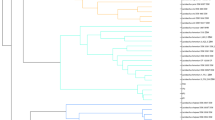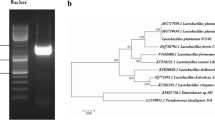Abstract
Some lactic acid bacteria produce volatile phenols in culture medium but this activity has not been extensively studied in wine conditions. Red and white wines were mixed with MRS medium at different ratios to study the influence of wine on the metabolism of p-coumaric and ferulic acids by Lactobacillus plantarum. In MRS broth supplemented with these precursors at 10 mg l−1, only 4-ethylphenol was produced (1 mg l−1) while, in the presence of wine, 4-vinylphenol was also obtained. Both volatile phenols are produced in nearly equal amounts (1 mg l−1) or almost only 4-vinylphenol depending on the MRS:wine ratio. Thus, wine favours the accumulation of 4-vinylphenol. Ferulic acid was not or was weakly metabolized in the conditions studied.



Similar content being viewed by others
References
Bartowsky EJ (2008) Bacterial spoilage of wine and approaches to minimize it. Lett Appl Microbiol 48:149–156
Benito S, Palomero F, Morata A, Uthurry C, Suárez-Lepe JA (2009) Minimization of ethylphenol precursors in red wines via the formation of pyranoanthocyanins by selected yeasts. Int J Food Microbiol 132:145–152
Bertrand A (1981) Formation de substances volatiles au cours de la fermentation alcoolique. Incidence sur la qualité des vins. Colloque Societé Française de Microbiologie, Reims pp, pp 251–267
Campos F, Couto JA, Figueiredo AR, Tóth IV, Rangel AOSS, Hogg T (2009) Cell membrane damage induced by phenolic acids on wine lactic acid bacteria. Int J Food Microbiol 135:144–151
Cavin J-F, Andioc V, Etievant P, Diviès C (1993) Ability to wine lactic acid bacteria to metabolize phenol carboxylic acids. Am J Enol Vitic 44:76–80
Chatonnet P, Dubourdieu D, Boidron JN (1992) Le caractère phénolé des vins rouges: caractérisation, origine et moyen de lutte. Rev Fr d’Oenol 32:21–24
Chatonnet P, Dubourdieu D, Boidron JN, Lavigne V (1993) Synthesis of volatile phenols by Saccharomyces cerevisiae in wines. J Sci Food Agric 62:191–202
Chatonnet P, Dubordieu D, Boidron J (1995) The influence of Brettanomyces/Dekkera sp. and lactic acid bacteria on the ethylphenol content of red wines. Am J Enol Vitic 46:463–468
Couto JA (1996) Studies on the diversity, taxonomy and physiology of ethanol-tolerant lactobacilli isolated from Douro fortified wine. PhD Thesis, Escola Superior de Biotecnologia da Universidade Católica Portuguesa, Porto, Portugal
Couto JA, Campos F, Figueiredo R, Hogg T (2006) Ability of lactic acid bacteria to produce volatile phenols. Am J Enol Vitic 57:166–171
Fugelsang K, Edwards C (2007) Wine microbiology, practical applications and procedures, 2nd edn. The Chapman & Hall Enology Library, UK
Heresztyn T (1986) Metabolism of volatile phenolic compounds from hydroxycinnamic acids by Brettanomyces yeast. Arch Microbiol 146:96–98
Morata A, González C, Suárez-Lepe JA (2007) Formation of vinylphenolic pyranoanthocyanins by selected yeasts fermenting red grape musts supplemented with hydroxycinnamic acids. Int J Food Microbiol 116:144–152
Ribéreau-Gayon P, Dubourdieu D, Donèche B, Lonvaud A (2006a) Handbook of enology—volume 1—the microbiology of wine and vinifications, 2nd edn. Wiley, Chichester
Ribéreau-Gayon P, Glories Y, Maujean A, Dubourdieu D (2006b) Handbook of enology—volume 2—the chemistry of wine stabilization and treatments, 2nd edn. Wiley, Chichester
Rodríguez H, Curiel JA, Landete JM, De Las Rivas B, de López Felipe F, Gómez-Cordovés C, Mancheño JM, Muñoz R (2009) Food phenolics and lactic acid bacteria. Int J Food Microbiol 132:79–90
Sánchez-Patán F, Tabasco R, Monagas M, Requena T, Peláez C, Moreno-Arribas MV, Bartolomé B (2012) Capability of Lactobacillus plantarum IFPL935 to catabolize flavan-3-ol compounds and complex phenolic extracts. J Agric Food Chem 60:7142–7151
Silva I, Campos F, Hogg T, Couto JA (2011a) Factors influencing the production of volatile phenols by wine lactic acid bacteria. Int J Food Microbiol 145:471–475
Silva I, Campos F, Hogg T, Couto JA (2011b) Wine phenolic compounds influence the production of volatile phenols by wine-related lactic acid bacteria. J Appl Microbiol 111:360–370
Suarez R, Suarez-Lepe JA, Morata A, Calderon F (2007) The production of ethylphenols in wine by yeasts of the genera Brettanomyces and Dekkera: a review. Food Chem 102:10–21
Acknowledgments
This work was supported by national funds from FCT–fundação para a ciência e a tecnologia through project PEst-OE/EQB/LA0016/2011.
Author information
Authors and Affiliations
Corresponding author
Rights and permissions
About this article
Cite this article
Fras, P., Campos, F.M., Hogg, T. et al. Production of volatile phenols by Lactobacillus plantarum in wine conditions. Biotechnol Lett 36, 281–285 (2014). https://doi.org/10.1007/s10529-013-1351-y
Received:
Accepted:
Published:
Issue Date:
DOI: https://doi.org/10.1007/s10529-013-1351-y




